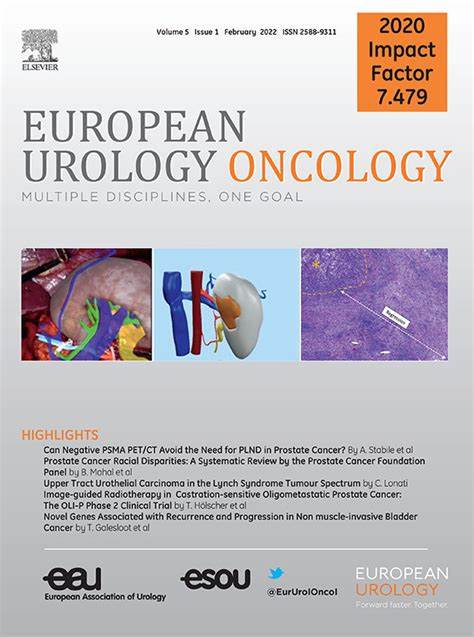Association Between the Decipher Genomic Classifier and Prostate Cancer Outcome in the Real-world Setting
IF 9.3
1区 医学
Q1 ONCOLOGY
引用次数: 0
Abstract
Background and objective
Although the prognostic significance of the Decipher prostate cancer genomic classifier (GC) has been established largely from analyses of archival tissue, less is known about the associations between the results of Decipher testing and oncologic outcomes among patients receiving contemporaneous testing and treatment in the real-world practice setting. Our objective was to assess the associations between the Decipher GC and risks of metastasis and biochemical recurrence (BCR) following prostate biopsy and radical prostatectomy (RP) among patients tested and treated in the real-world setting.
Methods
A retrospective cohort study was conducted using a novel longitudinal linkage of transcriptomic data from the Decipher GC and real-world clinical data (RWD) aggregated from insurance claims, pharmacy records, and electronic health record data across payors and sites of care. Kaplan-Meier and Cox proportional hazards regressions were used to examine the associations between the GC and study outcomes, adjusting for clinical and pathologic factors.
Key findings and limitations
Metastasis from prostate cancer and BCR after radical prostatectomy, Decipher GC continuous score, and risk categories were evaluated. We identified 58 935 participants who underwent Decipher testing, including 33 379 on a biopsy specimen and 25 556 on an RP specimen. The median age was 67 yr (interquartile range [IQR] 62–72) at biopsy testing and 65 yr (IQR 59–69) at RP. The median GC score was 0.43 (IQR 0.27–0.66) among biopsy-tested patients and 0.54 (0.32–0.79) among RP-tested patients. The GC was independently associated with the risk of metastasis among biopsy-tested (hazard ratio [HR] per 0.1 unit increase in GC 1.21 [95% confidence interval {CI} 1.16–1.27], p < 0.001) and RP-tested (HR 1.20 [95% CI 1.17–1.24], p < 0.001) patients after adjusting for baseline clinical and pathologic risk factors. In addition, the GC was associated with the risk of BCR among RP-tested patients (HR 1.12 [95% CI 1.10–1.14], p < 0.001) in models adjusted for age and Cancer of the Prostate Risk Assessment postsurgical score.
Conclusions and clinical implications
This real-world study of a novel transcriptomic linkage conducted at a national scale supports the external prognostic validity of the Decipher GC among patients managed in contemporary practice.
Patient summary
This study looked at the use of the Decipher genomic classifier, a test used to help understand the aggressiveness of a patient’s prostate cancer. Looking at the results of 58 935 participants who underwent testing, we found that the Decipher test helped estimate the risk of cancer recurrence and metastasis.
真实世界中解密基因组分类器与前列腺癌结果之间的关系
背景和目的:尽管Decipher前列腺癌基因组分类器(GC)的预后意义主要是通过分析档案组织确定的,但人们对Decipher检测结果与在现实世界中接受同期检测和治疗的患者的肿瘤预后之间的关系知之甚少。我们的目的是评估在实际环境中接受检测和治疗的患者在前列腺活检和根治性前列腺切除术(RP)后,Decipher GC 与转移和生化复发(BCR)风险之间的关联:采用一种新颖的纵向链接方法,将来自Decipher GC的转录组数据与真实世界的临床数据(RWD)进行了回顾性队列研究,真实世界的临床数据来自保险理赔、药房记录以及跨支付方和医疗机构的电子健康记录数据。在对临床和病理因素进行调整后,采用卡普兰-梅耶尔和考克斯比例危险度回归法检验GC与研究结果之间的关联:对根治性前列腺切除术后的前列腺癌转移和BCR、Decipher GC连续评分和风险类别进行了评估。我们确定了 58 935 名参与者接受了 Decipher 检测,其中 33 379 人接受了活检标本检测,25 556 人接受了前列腺癌根治术标本检测。活检样本的中位年龄为 67 岁(四分位间距 [IQR] 62-72),RP样本的中位年龄为 65 岁(四分位间距 [IQR] 59-69)。活检检测患者的 GC 中位数为 0.43(IQR 0.27-0.66),RP 检测患者的 GC 中位数为 0.54(0.32-0.79)。GC与活检检测的转移风险独立相关(GC每增加0.1个单位的危险比[HR]为1.21[95%置信区间{CI}为1.16-1.27],P 结论和临床意义:这项在全国范围内开展的新型转录组联系的真实世界研究支持了Decipher GC在当代实践中管理的患者中的外部预后有效性。患者摘要:这项研究调查了Decipher基因组分类器的使用情况,该检测有助于了解患者前列腺癌的侵袭性。通过观察 58 935 名接受测试的参与者的结果,我们发现 Decipher 测试有助于估计癌症复发和转移的风险。
本文章由计算机程序翻译,如有差异,请以英文原文为准。
求助全文
约1分钟内获得全文
求助全文
来源期刊

European urology oncology
Multiple-
CiteScore
15.50
自引率
2.40%
发文量
128
审稿时长
20 days
期刊介绍:
Journal Name: European Urology Oncology
Affiliation: Official Journal of the European Association of Urology
Focus:
First official publication of the EAU fully devoted to the study of genitourinary malignancies
Aims to deliver high-quality research
Content:
Includes original articles, opinion piece editorials, and invited reviews
Covers clinical, basic, and translational research
Publication Frequency: Six times a year in electronic format
 求助内容:
求助内容: 应助结果提醒方式:
应助结果提醒方式:


